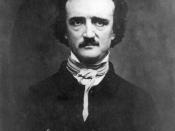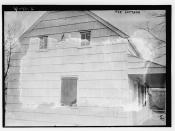In "The Tell-Tale Heart," Edgar Allan Poe revolves the story around a raving individual and the object in which he obsesses over. This theme of insanity is progressed throughout the entire story by Poe's style of gothic writing. Gothic-style writing is defined by using these elements: abnormal psychological behavior, creating a gloomy or threatening atmosphere, connections between the setting and its characters' thought processes or behavior, and supernatural components. Poe's usage of these gothic elements builds up the central theme in the "The Tell-Tale Heart."
Poe's major element of gothic literature, which establishes the main theme of insanity, is the use of abnormal psychological behavior. The narrator proves his insanity at the very beginning by ranting about his nervousness and states his fear that the reader will assume he is mad, "How, then, am I mad? Hearken! And observe how healthily--how calmly I can tell you the whole story," (The Gold-Bug and other tales*, pg.
74). The mere fact that he is afraid of being thought of as a madman does not prove that his psyche is abnormal. Poe manifests the narrator's insanity by having him state that his preconceived murder has no purpose, "It haunted me day and night. Object there was none. Passion there was none," (GB, pg. 74). The reader can see the narrator's madness again after he divulges his plan to the reader, stating, "Ha!--would a madman have been so wise as this?" (GB, pg. 74). Eventually the narrator's mind gets the best of him and he kills the old man, but afterwards, his attitude is down right odd and sadistic, "In an instant I dragged him to the floor, and pulled the heavy bed over him. I smiled gaily, to find the deed so far done," (GB, pg. 76). By having...



Good Comment
I think the writer could grasp Poe's technique of writing very well. It is well defended with examples and proofs from the story itself.
1 out of 1 people found this comment useful.